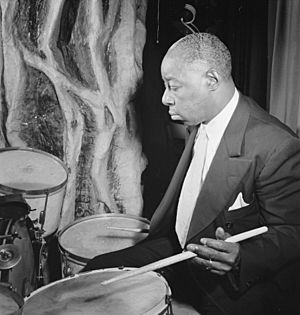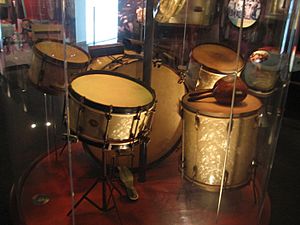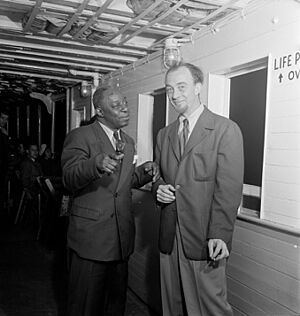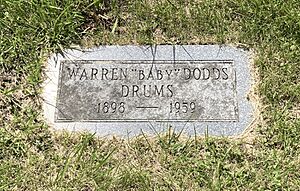Baby Dodds facts for kids
Quick facts for kids
Baby Dodds
|
|
|---|---|

Baby Dodds, New York, around December 1946. Image: William P. Gottlieb
|
|
| Background information | |
| Birth name | Warren Dodds |
| Born | December 24, 1898 |
| Origin | New Orleans, Louisiana, US |
| Died | February 14, 1959 (aged 60) Chicago, Illinois, US |
| Genres | Jazz, Dixieland |
| Occupation(s) | Musician |
| Instruments | Drums |
| Associated acts | Sonny Celestin, Johnny Dodds, Art Hodes, Fate Marable, Jelly Roll Morton |
Warren "Baby" Dodds (born December 24, 1898 – died February 14, 1959) was an amazing American jazz drummer. He was born in New Orleans, Louisiana, USA. Many people think he was one of the best jazz drummers before the "big band" era. This was a time when jazz bands were smaller. Baby Dodds was also one of the first drummers to record his music while making it up on the spot! He played his drums with lots of cool changes and special sounds. He usually kept the main beat with his big bass drum. Then he added quick, soft rolls on his snare drum.
Contents
Early Life and Music
Baby Dodds was the younger brother of famous clarinet player Johnny Dodds. His family was very musical. His father and uncle played the violin. His sister played the harmonica. The family also sang hymns together often.
When Baby Dodds was a boy, he really wanted to play drums. He told a story about making his first drum. He used a lard can and some chair rungs for drumsticks! When he was 16, he saved enough money to buy a real drum set.
Many jazz drummers in New Orleans helped him learn. He started playing in street parades with Bunk Johnson's band. Then he joined Willie Hightower's band, the American Stars. They played in many places around New Orleans. Baby Dodds heard famous musicians like Buddy Bolden and Jelly Roll Morton. He also played with bands led by Frankie Duson and Sonny Celestin.
In New Orleans, it was a tradition to play jazz music during funeral marches. Baby Dodds explained that this music was not disrespectful. Instead, it was a way to help people feel happy and celebrate life.
Becoming a Top Jazz Drummer
Baby Dodds became known as a top young drummer in New Orleans. In 1918, he joined Fate Marable's riverboat band. A young Louis Armstrong also joined this band. They played on boats that traveled up the Mississippi River. They played jazz, popular songs, and classical music.
In 1921, Dodds and Armstrong left Fate Marable's band. Soon after, Dodds joined King Oliver's Creole Jazz Band. This band included his brother Johnny Dodds on clarinet. They moved to California in 1921. Then, in 1922, they moved to Chicago. Louis Armstrong also joined the band in Chicago. Baby Dodds said playing with this band was "a beautiful experience."
King Oliver's Creole Jazz Band broke up in 1924. After that, Baby Dodds recorded with many famous musicians. These included Louis Armstrong, Jelly Roll Morton, Art Hodes, and his brother Johnny Dodds. Baby Dodds played in Louis Armstrong's famous Hot Five and Hot Seven groups.
Later Years and Challenges
After the King Oliver band ended, the Dodds brothers played together in Chicago. Johnny Dodds started his own band, and Baby was part of it. Sadly, Johnny Dodds passed away in 1940. Baby Dodds said his brother's passing changed his life a lot. He had to play music on his own after that.
After his brother's death, Baby Dodds worked as a freelance drummer. This was during a time called the New Orleans Revival. Many jazz fans wanted jazz to go back to its original style. Baby Dodds' drumming style was perfect for this. He played in the traditional New Orleans way.
In the late 1940s, he worked in New York City. He also recorded music with Bunk Johnson. Baby Dodds noticed that in New York, people listened to jazz more than they danced to it. He said it felt strange because he was used to people dancing to his music.
In 1948, he toured Europe with Mezz Mezzrow's group. They played only in France. Baby Dodds loved it there. He felt that Europeans took jazz music more seriously than people in America. They played at the Nice Jazz Festival with other American jazz musicians.
After his European tour, Baby Dodds returned to Chicago. He faced some health challenges in his later years. He passed away on February 14, 1959, in Chicago. He is buried at Lincoln Cemetery in Blue Island, Illinois.
Baby and Johnny Dodds
Baby and Johnny Dodds were brothers and musicians. When they were young, Johnny got a clarinet, but Baby did not get a drum. Baby Dodds wrote in his book that he felt a bit jealous of his older brother.
But as they grew up, their relationship changed. When King Oliver hired Baby, Johnny saw how much Baby's drumming talent had grown. They became closer as brothers and musicians. Baby Dodds was very sad when his brother passed away.
The Baby Dodds Story
In 1959, a book called The Baby Dodds Story was published. It was based on interviews with Baby Dodds by Larry Gara. The book tells Baby Dodds' life story in his own words.
Larry Gara interviewed Baby Dodds every Sunday for about twelve weeks in 1953. Gara wanted the book to be Baby Dodds' story, not his own. He also worked with jazz historian Bill Russell. Russell helped check the details in Dodds' interviews to make sure they were correct. Even if some small details might be a bit exaggerated, the book gives a great look at early jazz through Baby Dodds' eyes.
Recording His Music
In many of his early recordings, Baby Dodds had to use a wood block. This was because the recording technology back then was not very good for drums. So, it was hard to hear his full drumming style on those early records.
But Baby Dodds started recording again in 1940. By then, the technology was much better. It could really show off his amazing talent on the drum set. Baby Dodds might have been the first jazz drummer to record music all by himself. In 1945, he recorded two drum solos. The next year, he recorded more solos and shared stories about his drumming. This record helps us imagine what he sounded like in his best years.
Baby Dodds' Drumming Style

People still admire Baby Dodds for his creative drumming. He believed in playing something different for every part of a song. Most drummers at the time played a short roll on the 2nd and 4th beats. But Dodds played a longer roll that flowed into the next beat. This made the music feel smoother. He later developed this into the "jazz ride pattern" that drummers still use today.
Baby Dodds was best known for his "shimmy beat." He first used it in 1918. He said a French soldier once heard his music and started to shake all over. Baby Dodds tried to do the same thing, and that became his "shimmy beat." Louis Armstrong loved it! He said watching Dodds play with his "shimmy" was worth the price of admission.
Baby Dodds also thought it was important to listen to the other musicians in the band. He wanted his drumming to fit their style. He tried to get to know each band member. He felt it was the drummer's job to help the band play together well. He said, "When a man is playing it's up to the drummer to give him something to make him feel the music and make him work."
Interestingly, Baby Dodds never liked hi-hat cymbals. He said, "I didn't like them and I still don't. Some drummers can't play without them. I can't play with them."
Discography
- "Jazz à La Creole" (Baby Dodds Trio)
- "Baby Dodds"
- "Talking and Drum Solos"
- "Live At New York Town Hall 1947" (Mezz Mezzrow and Sidney Bechet-1947)
- "Bunk Johnson- The King Of The Blue"
- "Albert's Blues / Buddy Bolden Blues" Tell Record 29655 (78RPM)
Book
- The Baby Dodds Story Edition: As Told to Larry Gara
Hall of Fame
In 2010, Baby Dodds was added to the DownBeat magazine Hall of Fame. This special committee looks for jazz artists who were not fully recognized during their lifetime. The magazine said that early recording technology made it hard to hear Dodds' full talent. Also, the hi-hat cymbal was not invented yet when he was in his prime. So, by today's standards, he played with a simpler drum set for much of his career.
Images for kids
See also
 In Spanish: Baby Dodds para niños
In Spanish: Baby Dodds para niños




